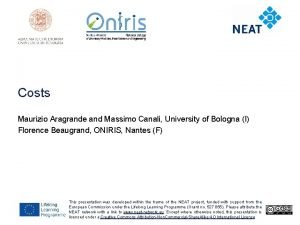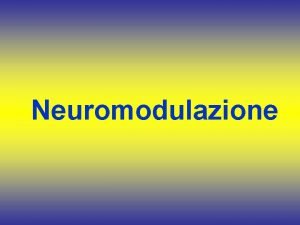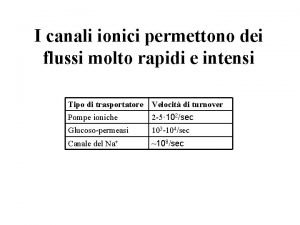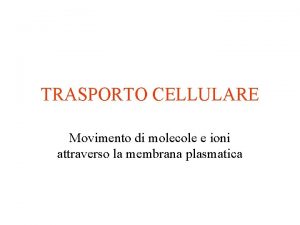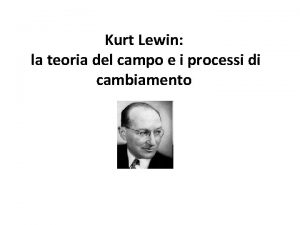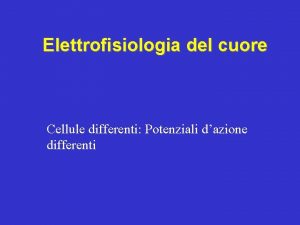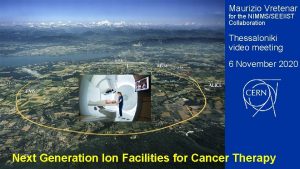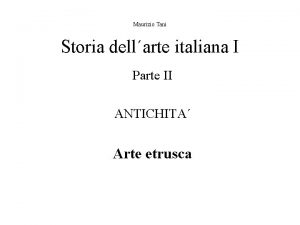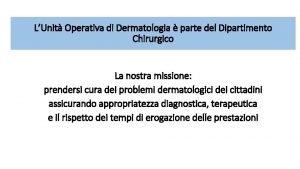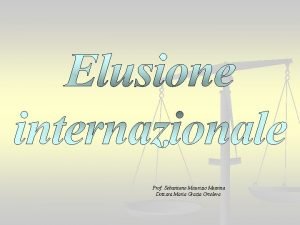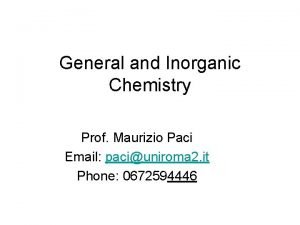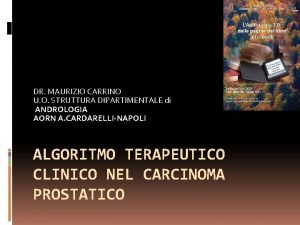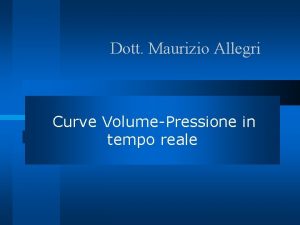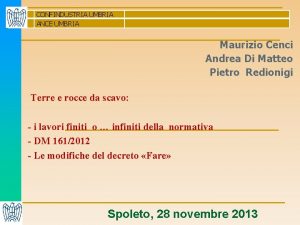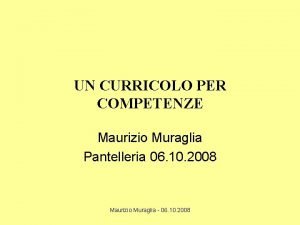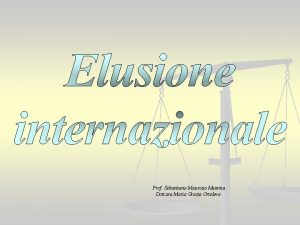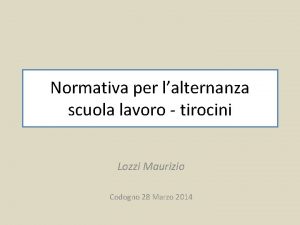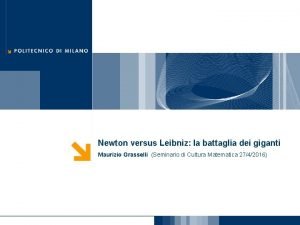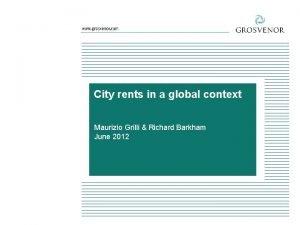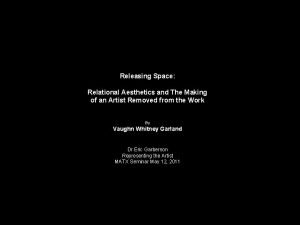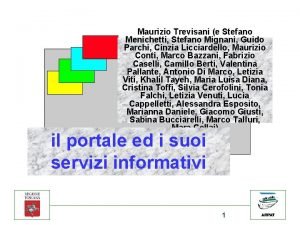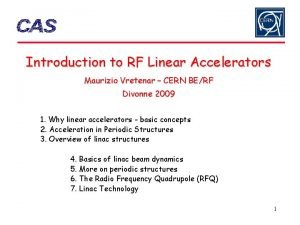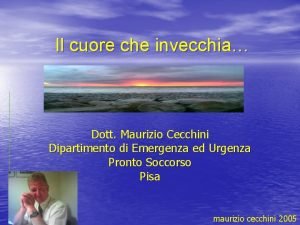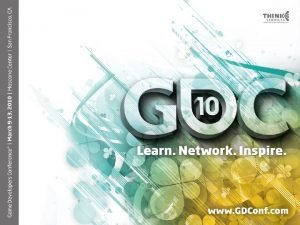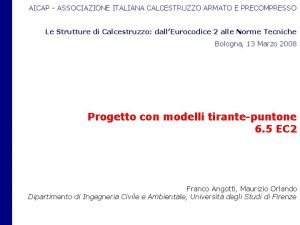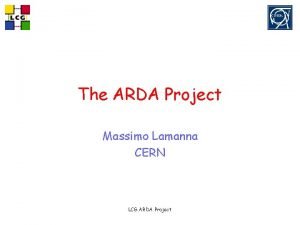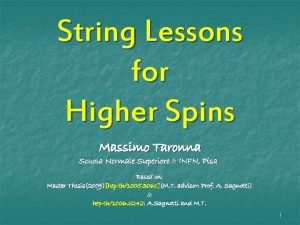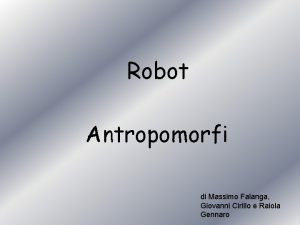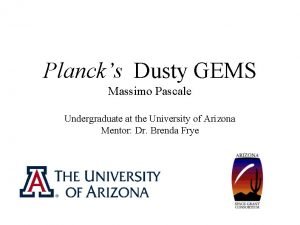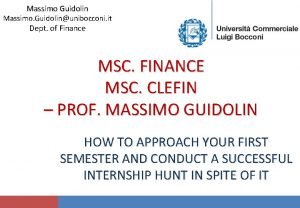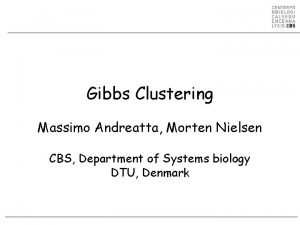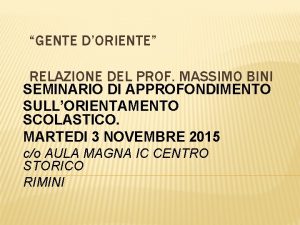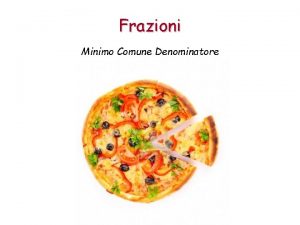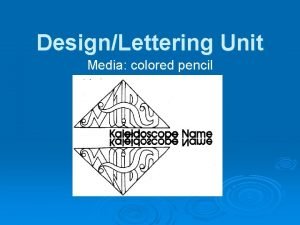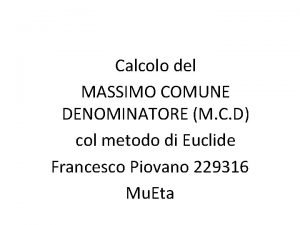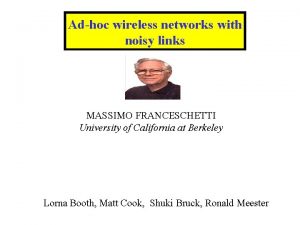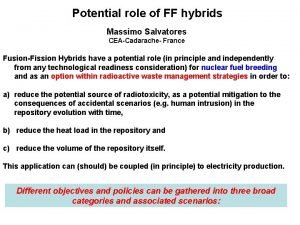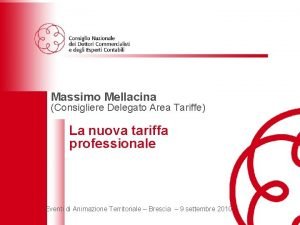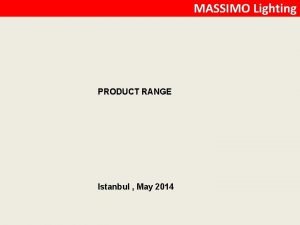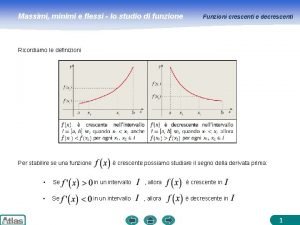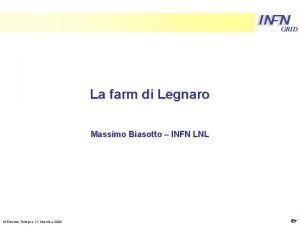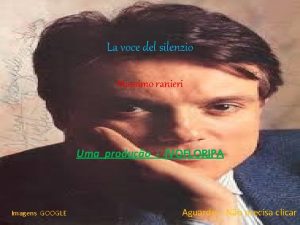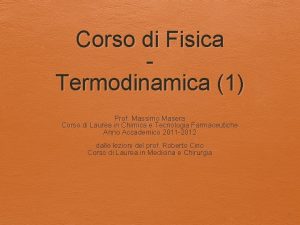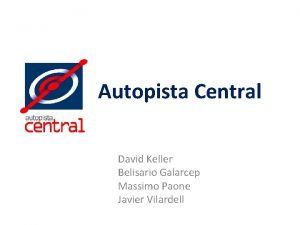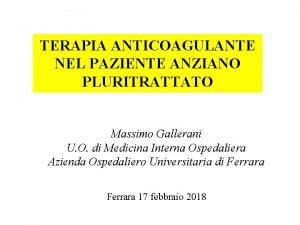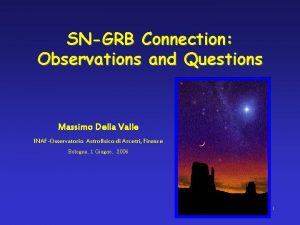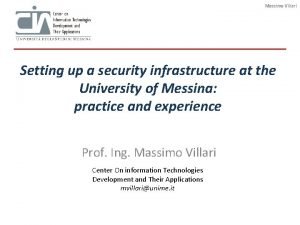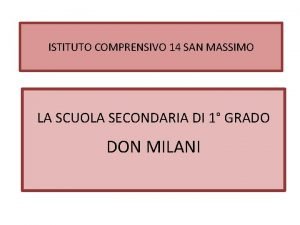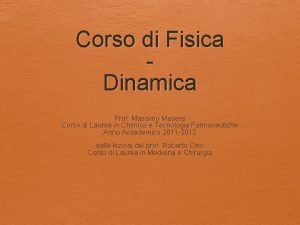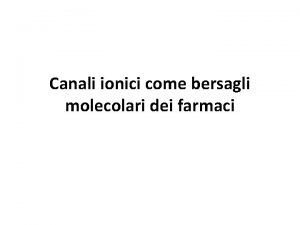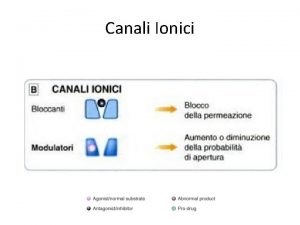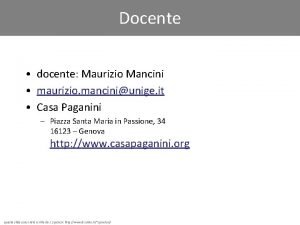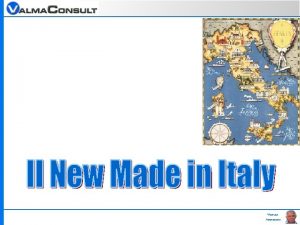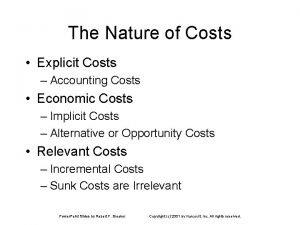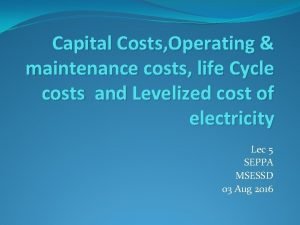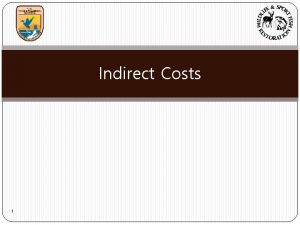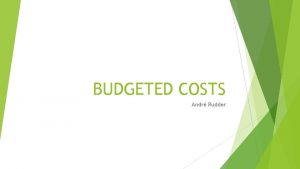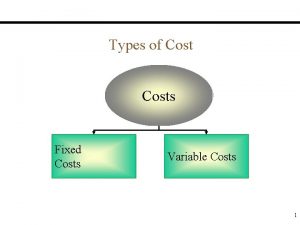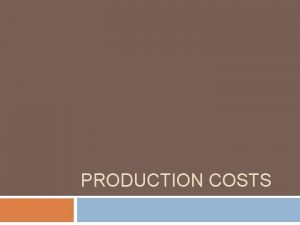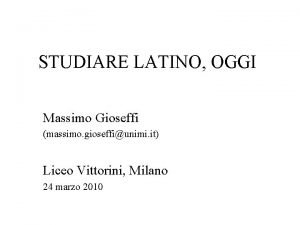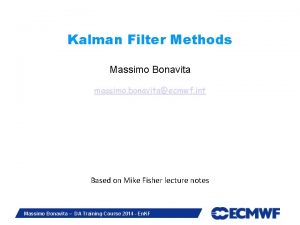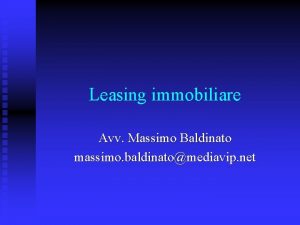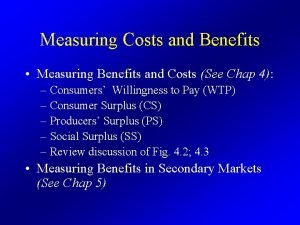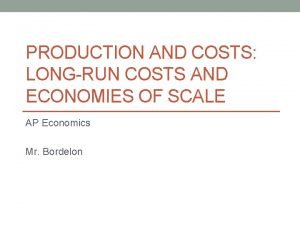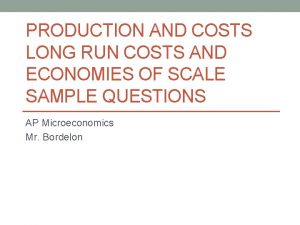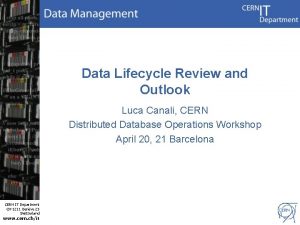Costs Maurizio Aragrande and Massimo Canali University of






























































- Slides: 62

Costs Maurizio Aragrande and Massimo Canali, University of Bologna (I) Florence Beaugrand, ONIRIS, Nantes (F) This presentation was developed within the frame of the NEAT project, funded with support from the European Commission under the Lifelong Learning Programme (Grant no. 527 855). Please attribute the NEAT network with a link to www. neat-network. eu. Except where otherwise noted, this presentation is licensed under a Creative Commons Attribution-Non. Commercial-Share. Alike 4. 0 International License.

Learning objectives § Cost identification, cost justification, cost definition (Section 1) § Identify how costs play in the animal health context (Section 2) § Identify the way inputs generate costs (Section 3) § Describe how individual behaviors may determine social cost (Section 4) 2

Section 1: Costs in general 1. 1 - Cost: what is this? 1. 2 - Opportunity cost 1. 3 - Resources, inputs, costs 3

1. 1 – Cost : what is it? 4

1. 1 - Cost : what is this? Chapter 4 A lexical approach § Cost is a term commonly used by people: § By families or individuals, when they purchase something § By farmers, when they purchase feed, machinery or build a cowshed in order to produce farm staples § By professional veterinarians, when they purchase e. g. laboratory hardware, hire a secretary or a colleague in order to perform their profession § The term cost is often associated to other terms or adjectives which identify particular aspects of the cost concept. Some examples: § Total cost and average cost Can you associate a meaning to these terms? § Fixed cost and variable cost Can you define the difference, for example, between a fixed cost and a variable cost? § Monetary cost and non monetary cost § Individual and social cost Or: can you provide some examples? 5

1. 1 - Cost : what is this? Chapter 4 An exercise in cost identification § In the table below we listed some examples of real costs. Try to identify what kind of cost they are and to develop a reasoning to justify your choice Identifying costs categories Cost examples Cost identification The money I spend for the fuel (Fixed or variable? Social or individual? Average or total? ) The cost of the car insurance (Fixed or variable? Social or individual? Average or total? ) The vaccination cost for my business travel abroad (Fixed or variable? Social or individual? Average or total? ) The cost of a public vaccination plan against brucellosis (Fixed or variable? Social or individual? Average or total? ) . . . 6

1. 1 - Cost : what is this? Identifying costs Chapter 4 § Fixed and variable costs identify two different ways through which inputs generate costs § This distinction is relevant when we want to analyze the relationship between the production volume and the use (the cost) of some resources in any activity For example: purchasing a milking machine costs once and lasts many years; a vet medicine costs each time we use it. § Monetary and non-monetary costs refer to costs that are easy to be quantified in monetary terms or not. § This distinction is relevant when we face situations related to marketable or nonmarketable goods. For example: the purchase of an ultrasound machine in a vet lab is a monetary cost; the pain we feel for our sick cat can be hardly quantified and monetized Cost analysis is applied in different situations. The various specifications applied to costs identify concepts which are useful to different analytical aims 7

1. 1 - Cost : what is this? Chapter 4 Finally, what is it? § Cost is the economic value of the resources we use to do something § Distinguishing among costs helps economists to develop cost analysis § The distinction among costs is based on some criteria which allow for the identification of cost categories § Cost categories are relevant to develop the cost analysis in a defined context and for a specific aim. 8

1. 2 – Opportunity cost 9

1. 2 - Opportunity cost Chapter 4 The economic justification for cost § Scarce resources make costs § Resource scarcity means that an individual or a society are constantly faced to choose among alternative uses of the resources. § This immanent condition of the human beings is a basic assumption of the economics. The scarcity problem concerns relevant economic issues as well as daily life: Should a state produce more bread or more guns? Should I use my time to work (and get more money) or to go on holidays? § One day more spent for holidays reduces my worktime. (2) Any choice implies a renounce. This renounce is a cost. 10

1. 2 - Opportunity cost Chapter 4 An exercise, to visualize the concept § Imagine that: § You have a fixed amount of a resource (a stock of time) § You can choose to allocate this resource to two alternative uses X= time for holidays; and: Y= time for work § How can you visualize the alternatives (by a graph). . . and the consequences (in economic terms)? 11

1. 2 - Opportunity cost Chapter 4 A more formal definition of opportunity cost § If I chose to have a little bit more of X (+d. X)… … I will get a little bit less of Y (- d. Y) § - d. Y is the Opportunity Cost of +d. X Opportunity Cost “The loss of other alternatives when one alternative is chosen. ” (2) 12

1. 2 - Opportunity cost Chapter 4 From opportunity cost to real cost (I) § How does the opportunity cost concept works in reality? § Imagine a situation where two “economic agents” (Mr Worker and Mr Farmer) have to decide how allocate their resources (time, competences) to perform their job and get a revenue: Mr. Farmer breeds cows to produce milk. Mr. Worker is a worker specialized in cow milking. He offers his job on the market. He has to milk his cows and organize the financial plan of the farm. He identifies the opportunity cost between employment time and non-employment time. Budgeting is a strategic activity. One day employed in this operation may save much money to the farm (say 100 €/day) Then he translates in money the sacrifice of 1 day of non-employment time (assumed to be the preferred alternative). This is the price he requires for 1 work unit (say 40€/day) Milking, operated by Mr Farmer, would just save 40€/day (the amount Mr Farmer spends if he hires Mr Worker) 13

1. 2 - Opportunity cost Chapter 4 From opportunity cost to real cost (II) § How will Mr Farmer allocate his time between budgeting and milking? § He compares the opportunity cost of the alternatives: Milking has an opportunity cost of 100 €/day Budgeting has an opportunity cost of 40 Operation Mr Farmer (€/day) Opportunity cost (€/day) Budgeting 100 40 Milking 40 100 § He decides for the alternative whit the lower opportunity cost (budgeting in this case) 14

1. 3 – Resources, value, costs 15

1. 3 - Resources, value, cost Chapter 4 Let’s combine some basic concepts § Opportunity cost outlines resource scarcity § Resource scarcity stimulates people to value resources § We use resources as inputs to implement an action or a process, that will produce benefits The value of an input used in a process is a cost 16

1. 3 - Resources, value, cost Chapter 4 How can we analyse the cost of a process? § Resources and inputs are of many kinds and contribute to the production in many ways § The development of a cost analysis requires that we describe the mechanisms that generate costs § Before doing this, let’s spend a some time to have an insight of the animal health system in relation to cost § Costs are faced to get benefits • Who pays (and faces costs) in change of what (what benefits, goods, services)? • How this works when animal health is the focus of the social and economic relationships among people? 17

Section 2: Costs in relation to animal health 18

2 – Costs in relation to animal health Chapter 4 Who is concerned by costs in relation to animal health? § Many actors deal with animals for different reasons or motivations Who? (actors) Private owners of animals Public institutions Which economic reason? (Producers) revenue, profit (Households) utility from good feelings for pets Improve economy and welfare through animal production Reduce health risks related to animals, animal production and consumption of animal products Veterinarians Revenue, profit Society as a whole Life standards (avoid welfare losses), avoid sickness while using animals to satisfy different kinds of needs 19

2 – Costs in relation to animal health Chapter 4 Why do actors face cost for animal health? § Motivations determine the reasons for each actor to support costs for animal health Who Why Individual owners Producers: suffer losses because of animal sickness →They accept to support monetary costs to defend the health of their animals, because these are a source of revenue Families: suffer for animal sickness, a loss of utility difficult to translate into money (non-monetary cost) → They are willing to spend money to restore puppies’ health because they care Public institutions They spend money by trying to reduce the social risk related to animal disease on a large scale (loss of animal production, food scare, transmission of diseases among animal and to humans, etc. ) → They spend money to safeguard health standards, prevent (or intervene in) animal health outbreaks, avoid social damages, etc. The veterinarians Veterinarians employ their time and competence for interventions in clinic or in the field. This is their profession; → They spend money to move around, to manage vet office or hospital, update or improve their scientific knowledge. Society as a whole Society cares to avoid disease transmission, food scare and similar events that may cause losses of social welfare (in term of health, revenue, insecurity) → Individuals may face costs to restore welfare. 20

2 – Costs in relation to animal health Chapter 4 Which role does each actor play in animal health? § Different actors play different roles in animal health o Any role comes with some functions to be developed o To develop a function, actors must use resources and face costs 21

2 – Costs in relation to animal health Chapter 4 Which costs are related to each actor/role/function? § When actors spend money for animal health, what do they materially buy? Actors Individual owners Public institutions Costs Producers: animals, buildings, feed, drugs, machinery, management, consultancy, workers, . . Families: feed, drugs, recovery, consultancy Veterinarians, supporting staff, labs’ materials, . . Veterinarians Vet’s time, staff, office, medical facilities and equipments, surgery room, microscope, . . Society as a whole Life quality (safe food, health insurance, wild animals preservation, . . . ) 22

2 – Costs in relation to animal health A simple exercise Chapter 4 § Could you find out similarity and differences among the resources mentioned in the previous table? § Which criteria do you use to determine similarity and differences? § Are these criteria relevant on an economic perspective? Economics looks at how inputs generate costs and classify costs according to cost generating mechanisms 23

Section 3: Cost generating mechanisms 3. 1 - Costs and production 3. 2 - Investments 3. 3 - Costs over time 3. 4 - Economic and financial aspects of costs 3. 5 - Cost functions 3. 6 - Average cost and economies of scale 3. 7 - Organizational options 24

Chapter 4 3. 1 Costs and production 25

3. 1 - Costs and production Chapter 4 Input use and production One of the most relevant mechanism of cost generation is the relationship between input use and production increase q Two situations can be exemplified § Mr. Farmer buys feed for his cow § More feed > More cost > More milk § Mr. Farmer buys a tractor for 100. 000 €, to be used during the next 10 years § The value of the tractor decreases along this period at the rate of 10. 000 €/year: this amount is related to machine availability for Mr. Farmer, and does not depend if Mr Farmer uses the machine 3 or 15 hours/day q. What is the difference between these two types of cost? 26

3. 1 - Costs and production Chapter 4 Variable and fixed costs (I) q Variable costs § Variable costs are costs that change depending on variations in the size of the activity: they increase with the increase of production and decrease when production is reduced; § Common examples of variable costs are given by the use of inputs entirely consumed in one production cycle; e. g. in milk production variable costs may consist in expenses for: • Feed • Veterinary assistance • Fuel • Hired labour paid per hour, day, or unit of product • Electricity (only the elements related • to consumption) • Drugs • Rent of machinery • Fertilizers, seeds, and pesticides forage crops etc… 27

3. 1 - Costs and production Chapter 4 Variable and fixed costs (II) q Fixed costs § Fixed costs are costs that do not vary in the short term, even though the business’ activity, production volume and sales are significantly reduced; § Some common examples of fixed costs are: • Depreciation of tangible assets (machinery, buildings, tools, office equipment, etc. ) • Salaries paid to permanent employees of a company • Amortization of intangible assets (patents, trademarks, etc. ); • Rents paid to landlords for the use of real estates • Interests paid on loans used to buy assets • Premiums paid for insurance on assets • Property taxes • etc. . . 28

3. 1 - Costs and production Chapter 4 Similarity among production processes q Fixed and variable inputs are used in any production context § Mr. Vet spends 0. 50 € for each cat vaccination kit § More vaccinations > More cost > More client served § Mr. Vet obtains a loan to buy the equipment of a surgery room § He will pay 1, 000 €/month for 8 years § Either he uses the room for 7 or 15 surgeries per month, the bank will ask him 1, 000 € every month over 8 years A relevant aspect of cost analysis is the ability to distinguish between variable and fixed cost in any context and understand the consequences for management 29

Chapter 4 3. 2 Investments 30

3. 2 - Investments Chapter 4 Fixed costs and investments q An investment is time, energy, matter, money. . . resources spent once on expectation of future benefits. money revenue § Some example: Your training: you spend money and time learning a lot during 6 years; your hope is that you will have a job and revenues during the next 40 years. 1 -6 7 -47 time & money spent for training money Revenues from farmers As a vet, you buy a car on year 1 to visit farmers. You get money from your work for several years thanks to your car. 1 2 3 4 time money spent for the car 31

3. 2 - Investments Chapter 4 Investment and uncertainty q An investment is made on the basis of a subjective evaluation on future activities, but nobody can exactly know what level of activity there will be in the future. Suppose that: You stop working to take care of your children (and you didn’t plan it!) A new vet recently installed in the area and he is very strong with bovines. This reduces your revenue from farmers. . . but you didn’t know when you bought a new car to visit farmers abroad Investment is sunk, you cannot get money/time back easily. Investment is always affected by uncertainty on the return on investment. 32

Chapter 4 3. 3 Costs over time 33

3. 3 - Costs over time Chapter 4 Depreciation § The vet’s car of the previous example maintains its functionality for several years, which define the useful life period of the asset, but it losses value because of consumption § As a consequence, the value of the car gradually declines along its useful life period § This gradual loss of value is the cost related to the availability of the car. It is called depreciation and corresponds to the purchase value of the car distributed along its useful life period. § The accounting of the depreciation cost does not necessarily implies a corresponding cash outflow in the reporting year (see section 3. 4) 34

Chapter 4 3. 4 Economic and financial aspects of costs 35

3. 4 - Economic and financial aspects of costs Chapter 4 Costs and cash flows (I) The economic aspect of cost is related to the consumption of resources for production activities. The financial aspect of cost is related to the flows of money generated along time by production activities. § In the example of section 3. 3, the vet may have two options for buying the car: § 1) He may buy the car with its own money - in this case the vet has a cash outflow (area bordered by the red dashed line) for the whole price of the car at purchase ; - if after four years the car needs to be changed and has lost all its value, the cost of the car depreciation corresponds to the value of the car at purchase, but it is distributed along the four years of car utilization (grey dashed areas); - the vet has a cash outflow when he purchases the car, but he does not have any cash outflows when he accounts the yearly cost of use of the car money Revenues 1 2 3 4 time yearly cost of depreciation (4 years) money spent for the car (cash outflow) 36

3. 4 - Economic and financial aspects of costs Chapter 4 Costs and cash flows (II) § 2) A second option is that the vet may borrow a loan from a bank and repay it in four years: - in this case the vet makes use of the bank’s money to buy the car; - each year the vet supports the cost of car’s depreciation and also a corresponding outflow of money which pays back the loan received from the bank. Moreover the vet also pays the interest due to the bank as price of the loan; - the vet does not have a cash outflow when he purchases the car, but he does have yearly cash outflows corresponding to the yearly cost of use of the car money Revenues 1 2 interest on the loan (cash outflow) 3 4 time yearly costs of depreciation corresponding to the cash outflow for loan repayment 37

3. 4 - Economic and financial aspects of costs Chapter 4 Use of inputs, time and payments The two situations seem to be similar, but have very different implications. If we suppose that in year 3, for some reason, it happens that the vet’s customers do not pay the vet services: § in the second case (the vet has to repay a loan), the vet could be in the situation that he cannot afford his obligations with the bank … § … and the consequences may be significantly worse for his future activity than in the first case (in which he does not have a loan to pay back). 38

3. 4 - Economic and financial aspects of costs Chapter 4 Economic and financial balances For any business activity, it is necessary that the value generated by production (income) be greater than the value of all the inputs consumed along the production process (costs). But this is not enough to determine the sustainability of a business. In fact, it is also necessary that the business activity be always able to satisfy its obligations to payments in due time. A correct economic balance implies that a business activity create an income greater than costs (i. e. the value of production created should be greater than the value of inputs consumed). A correct financial balance implies that a business activity be always able to satisfy its obligations to payments in due time. Both conditions are necessary to define the sustainability of any business. 39

Chapter 4 3. 5 Cost functions 40

3. 5 - Cost functions Chapter 4 Variable and fixed cost functions § As seen, feed (variable inputs) and tractors (fixed inputs) have different cost generating mechanisms with production increase; § The type of fixed assets may limit the production volume § For example a small tractor may constrain the production. If a farmer wants to increase the production above a given level, he needs a bigger tractor, which probably implies higher fixed costs for depreciation. 41

3. 5 - Cost functions Chapter 4 Cost functions, sales and profit § A consequence of the difference between variable and fixed cost functions is that, in general: § a production process characterised by a high proportion of variable costs may generate a profit with relatively low levels of sales; § a production process characterised by a high proportion of fixed costs requires certain levels of sales to generate profit. But a good endowment of fixed assets may provide other advantages … 42

Chapter 4 3. 6 Average cost and economies of scale 43

3. 6 - Average cost and economies of scale Chapter 4 Total cost, average cost, production volume § The analysis of production costs may provide information on how costs change in relation to production volume § Think to a surgery room: how does cost change with utilization? And why? Inputs Cost of inputs Production cost for 50 h/year Production cost for 1, 000 h/year Vet staff work and other variable inputs 130 €/hour 6, 500 € 130, 000 € Use of surgery room (fixed input) 7, 500 €/year 7, 500 € (average cost) can be reduced if Total cost 14, 000 € 137, 500 € the use of the equipment is Cost of surgery (€/hour) 280 €/hour 137. 5 €/hour optimized. The cost per unit of product These are called ECONOMIES OF SCALE 44

3. 6 - Average cost and economies of scale Chapter 4 Economies of scale § Economies of scale may abate the average production cost of goods and services and may be specially effective in large production units; 45

Chapter 4 3. 7 Organizational options 46

3. 7 - Organizational options Chapter 4 Different options for the use of a machine q Mr. Farmer owns the machine he uses at farm § He did an investment years ago and repays a loan (fixed cost) q Mr. Vet bought an ultrasound machine § As in the case of Mr. Farmer, he has to repay a loan q Both of them are in trouble § They realized that their investments are oversized with respect to the use they actually do. They want to get rid of them, but they also want to use machine when they have need. How can they do? What are the consequences? q In term of cost, this problem has two faces. 47

3. 7 - Organizational options Chapter 4 Turning a fixed cost into a variable cost is possible § Investments can be dismantled and machinery and equipment can be rented § In this case, the cost generation mechanism changes § The purchase of machinery and equipment generates fixed costs § The renting of machinery or equipment generates variable costs The choices related to the use of a fixed input may actually turn a fixed cost into to a variable cost 48

3. 7 - Organizational options Chapter 4 The mechanism generating cost changes For a production level corresponding to Y the renting of the asset allows a profit, while the cost of an owned asset generate losses (it would be rentable only for a Y’ production level) But. . . you must consider that some costs are not reversible. . . 49

3. 7 - Organizational options Chapter 4 Sunk costs related to investments § The shifting from owning to renting the machinery implies that Mr Farmer and Mr Vet dismantle their investments; § The dismantling of investments generates losses: there are costs which cannot be recovered: § For the investment, they borrowed a 10, 000 € loan from the bank, they have to pay back 2, 000 €/year in 5 years; § At year 2 they dismantle the investment, they sell the equipment for 4, 000 € cash; § The net loss of dismantling is 2, 000 € (at the least!), resulting from: - Cash from equipment sale = + 4, 000 €; - Remaining loan payments (3 years x 2, 000) = - 6, 000 € Dismantling investments may generate costs that cannot be recovered or SUNK COSTS 50

3. 7 - Organizational options Chapter 4 Many costs are difficult to be attributed to specific activities § Direct vs indirect costs § When the use of an input is clearly related to a specific activity/product, it generates a Direct Cost; § Common examples of direct costs are the materials consumed exclusively for a specific process • feed, drugs, and veterinary assistance used for diary cows are direct costs of milk production • kits used for vaccination are direct costs of vaccination, etc. § However it is difficult to attribute every input to a specific process, especially when the activity of the business is diversified § The costs that cannot be associated to a specific process or activity are Indirect Costs. The aggregate of a business’ indirect costs is commonly indicated as Overheads 51

3. 7 - Organizational options Chapter 4 Overheads q Common examples of overheads are q The possibility of identifying direct the costs related to business costs or attributing overheads to a administration, use of fixed assets, specific activity depends largely utilities, taxation of assets, etc. : from the accuracy of the accountancy system § Salary of management and administration employees § Office supplies and consumables § Depreciation of office equipment; § Rent of facilities § Telephone and other utilities q The identification of direct costs is important (e. g. ) to evaluate the economic feasibility of a given activity and in general for decision making within a business § Equipment maintenance § Property tax § etc… 52

Chapter 4 Section 4: From private costs to social costs 53

4. From private costs to social costs Chapter 4 Individual behaviour and social costs § Mr Farmer breeds pigs. Consumers are happy with pig meat. But Mr Farmer’s neighbours are not happy with other “by-products” of Mr Farmer’s activity: air pollution, water pollution, noise, pig smell, etc. : § They should keep the windows closed even during summertime; § They should install air conditioning and water filtering at home; § Their kids cannot use the garden. Which are the economic consequences of Mr Farmer’s behaviour? How far and in which ways people and society may be damaged by Mr Farmer’s behaviour? § Mr Farmers neighbours should support unwanted costs due to Mr Farmer’s activity, they are limited in the use of their facilities and their houses lose value … but they do not receive any kind of compensation for that!!! They suffer the externalities of Mr Farmer activity. 54

4. From private costs to social costs Chapter 4 Externalities may generate benefits and costs § Any production activity generates externalities. § Externalities can be positive or negative § Pig meat satisfies consumer’s need (it contributes to food security) This is a positive externality § Pigs breeding creates pollution and other problems (it deteriorates neighbours’ quality life) This is a negative externality. To restore their quality of life, neighbours must afford additional costs Negative externalities from any production activity impose unwanted costs to some social categories 55

4. From private costs to social costs Chapter 4 Dealing with (negative) externalities § Externalities (especially the negative ones) challenge economists because they are difficult to evaluate § Pig meat produced by Mr Framers is sold to consumers. Its value is easily identified by a market mechanism (there is a demand there is a supply: the market establishes the price). Unfortunately, this is not always the case. . . § Some externalities are not valued through a market mechanism. This makes difficult to assess the value in monetary terms No market means no price. But no price doesn’t mean no VALUE! § Some externalities are far reaching, their effects are not immediately visible or tangible. They may hit the socio-economic system in different ways and far away from the origin of the problem. A careful understanding of the cause-to-effect chain within the socio-economic system is required 56

4. From private costs to social costs Chapter 4 The case of Aflatoxins § Aflatoxins are Mycotoxins found, among others, in maize. When this enters the food chain, it may endanger animals and, more seriously, human health. § Aflatoxins are dangerous for humans and animals when contaminated maize is consumed directly as food or feed. § By-products of Aflatoxins digestion in animals are found in animal food (meat, milk, eggs) and affect humans increasing the exposure to cancer risk in the long run. § Damages of minor entity (general pain, production reduction) are also found in animals, depending on the species. § What are the consequences of an Aflatoxins contamination when it affects the food chain? Are consequences readily assessed? How do they flow in the socio-economic system? Are they easily valuable? 57

4. From private costs to social costs Chapter 4 Cause-to-effect chain in the Aflatoxins case 58

4. From private costs to social costs Chapter 4 The Aflatoxins case in few words § Depending on the specific transmission chain of the contaminant agent. . . § Direct ingestion of contaminated food § Use of contaminated feed by animals, and transmission of digestion by-products into food §. . . the effects flow from the producers. . . § Producers may suffer marginal production and revenue losses §. . . to consumers, . . . § Consumers are more seriously exposed to health risk, which translate in food insecurity, increased medical expenses, §. . . to the whole society § More public money will be allocated to food controls, public health services, public information, preventative measures § Production and revenue losses will reduce the social welfare. 59

4. From private costs to social costs Chapter 4 Lessons learnt about externalities and costs § In economic terms, production makes sense because it creates benefits not only for producer but also for the society (food availability, social welfare). These are positive externalities § On the others side, production can also create bad outcomes (e. g. unexpected health risk) or negative externalities § Externalities are costs that are not taken into account by producers but are suffered by other categories or the whole society (unless corrective devices are applied) § In this sense, externalities are often cross-sectional cost as they are transmitted from one social category to another (producers vs. consumers) § Externalities may reduce resources availability for the next generations (like in the case of pollution). In this sense they are time-sectional costs 60

Chapter 4 Now you know about cost concepts and tools… …How can this help? § As a professional vet, your are advising Mr. Farmer about the way to solve mastitis diffusion among his cows. Two solutions are possible: § Improve the milking practices, or change milking devices How will Mr. Farmer take a decision? § A resilience of avian flu in the River Po Plane is a credible risk. Two solutions are possible: § Preventive vaccination of all hens, or accept the risk and prepare the stamping out of infected animals How will national health authority decide? These are management problems. Cost concept is a good basis to approach them but you need to know more. 61

Contacts Maurizio Aragrande, Massimo Canali DISTAL, University of Bologna Florence Beaugrand ONIRIS, Nantes maurizio. aragrande@unibo. it massimo. canali 2@unibo. it http: //www. neat-network. eu florence. beaugrand@oniris-nantes. fr http: //www. neat-network. eu 62
 Aragrande
Aragrande Canali della comunicazione
Canali della comunicazione Canali girk
Canali girk Raggio anidro definizione
Raggio anidro definizione Canali proteici definizione
Canali proteici definizione Teoria del campo psicologia
Teoria del campo psicologia Potenziale d'azione cellule pacemaker
Potenziale d'azione cellule pacemaker Maurizio vretenar
Maurizio vretenar Pallanti maurizio dermatologo
Pallanti maurizio dermatologo Maurizio bottoni pittore
Maurizio bottoni pittore Maurizio fauri
Maurizio fauri Marte di todi
Marte di todi Dermatologo nuova ricerca rimini
Dermatologo nuova ricerca rimini Maurizio vretenar
Maurizio vretenar Maria grazia ortoleva
Maria grazia ortoleva Maurizio paci
Maurizio paci Maurizio carrino
Maurizio carrino Maurizio allegri
Maurizio allegri Avv maurizio cenci
Avv maurizio cenci Maurizio muraglia
Maurizio muraglia Sebastiano maurizio messina
Sebastiano maurizio messina Maurizio
Maurizio Maurizio
Maurizio Maurizio
Maurizio Underrenting
Underrenting Maurizio cattelan
Maurizio cattelan Stefano mignani
Stefano mignani Cern
Cern Maurizio salaris
Maurizio salaris Dr maurizio cecchini
Dr maurizio cecchini Apb symbols
Apb symbols Associazione aicap
Associazione aicap Massimo lamanna
Massimo lamanna Massimo taronna
Massimo taronna Massimo falanga
Massimo falanga Massimo pascale
Massimo pascale Massimo guidolin
Massimo guidolin Massimo angiolini
Massimo angiolini What are 3 domains
What are 3 domains Massimo bini professore
Massimo bini professore Minimo comune denominatore frazioni algebriche
Minimo comune denominatore frazioni algebriche Colored pencil techniques worksheet
Colored pencil techniques worksheet Massimo moser
Massimo moser Mcd definizione
Mcd definizione Massimo franceschetti
Massimo franceschetti Massimo mitolo
Massimo mitolo Massimo salvatores
Massimo salvatores Massimo mellacina
Massimo mellacina Massimo lighting
Massimo lighting Come calcolare massimi minimi e flessi
Come calcolare massimi minimi e flessi Massimo biasotto
Massimo biasotto La voce del silenzio ranieri
La voce del silenzio ranieri Massimo ligazzolo
Massimo ligazzolo Massimo masera
Massimo masera Massimo masera
Massimo masera David belisario
David belisario Massimo gallerani
Massimo gallerani Massimo della gamma
Massimo della gamma Massimo della gamma
Massimo della gamma Massimo villari unime
Massimo villari unime Istituto comprensivo san massimo
Istituto comprensivo san massimo Massimo mariano psicologo
Massimo mariano psicologo Rotaia a cuscino d'aria descrizione
Rotaia a cuscino d'aria descrizione
